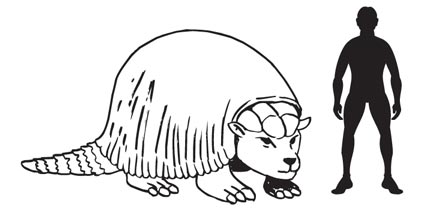New Research Indicates the Glyptodonts were Classy Swingers
A Sabre-toothed cat on the prowl for an easy meal, might mistake the slow moving, ground hugging glyptodont for an easy target, after all, this armoured prehistoric mammal was hardly able to flee from such a predator. However, as well as being covered in dermal body armour, strong enough to deter even the most ferocious bites, members of the Glyptodontidae had another means of defence, and a recent scientific study has provided an insight into just how effective this defence was.
Prehistoric Mammals
A number of glyptodont species have been named and described, many with elaborate tail spikes and clubs, some of which resemble medieval maces and other brutal weapons. A new study, from a team of South American scientists indicates that these clumsy looking beasts were able to swing their tails and clubs with the precision of a Kevin Petersen off-drive or a Roger Federer back hand.
Physicist Dr Rudemar Ernesto Blanco and his colleagues from the Faculty of Science in Montevideo, Uruguay conducted experiments to assess the mechanical efficiency of the various tail clubs found on glyptodonts. Their research, published in the scientific journal Proceedings of the Royal Society Biology, suggest that just like cricket bats and tennis racquets, the tails of glyptodonts had a “sweet spot” and this coincided with the positioning of the largest spike or part of the tail club.
This new study provides evidence that the glyptodonts were no push overs when it came to a prehistoric pecking order. Their tail spikes and clubs were highly adapted to deliver accurate, powerful blows on any other creature brave enough to challenge them. These tail clubs were not just used to fend of predators, but also used to settle disputes amongst rivals, perhaps fighting over mating rights. A number of glyptodont fossils have been discovered with broken skulls, perhaps testimony to the power and accuracy of a rival’s tail club.
Hitting the “Sweet Spot”
Stars of the tennis circuit or cricket know the importance of hitting the ball with the correct part of the bat, proper use of such equipment can prevent wrist injuries and ensure a tennis ball is hit with more power or a cricket ball is thumped effortlessly to the boundary. It seems that natural selection may have led to the evolution of “sweet spot” amongst glyptodonts.
A Scale Drawing of a Glyptodont (Glyptodon clavipes)

Picture credit: Everything Dinosaur
To see a scale model of a Glyptodon and other scale models of dinosaurs and prehistoric mammals, take a look at the CollectA Deluxe model range: CollectA Deluxe Prehistoric Life.
Dr Blanco and his team were inspired by previous studies into the mechanics of tennis racquets and baseball bats to try to engineer a better designed instrument for the sports person to use. A large, “sweet spot” or “centre of percussion” provides a considerable advantage. The glyptodonts originated in South America, perhaps the absence of large mammalian predators allowed this particular family from the order Xenarthra to grow large and evolve into many numerous forms. The fossil record shows that glyptodonts migrated into North America when the land bridge connecting South America to the northern part of the Americas was formed. Indeed, one member of the Xenarthra is still spreading northwards to this day – the armadillo.
Dr Blanco commented:
“We found in several of the large species the centre of percussion was almost at the same position of the largest spike in the tail. These spikes were probably useful to increase the damage during a tail blow like those in the middle age spiked mace”.
Studies of smaller species of glyptodonts carried out by the South American team indicate that smaller animals used their tail clubs in slightly different ways when compared to the larger species. These animals probably used their tail clubs in more varied ways with less power and precision.
Asked to comment on this aspect of their research Dr Blanco stated:
“We concluded several large species of glyptodonts used the tail clubs mainly for powerful blows in ritualised fighting but the small species used the tail clubs also in other situations as defence against predators”.
It seems that many of these larger species of glyptodonts (some were up to 3 metres long), were very capable of wielding their tail clubs with devastating effect. Perhaps the hungry Smilodon had better look elsewhere for a meal.
We at Everything Dinosaur have our very own “sweet spot” for the glyptodonts. As a fossil group, their significance cannot be doubted after all, Charles Darwin studied them and the Glyptodon name (means grooved or carved tooth) was first used by Sir Richard Owen. Glyptodonts are often included in Ice Age mammal box sets, although they were more associated with inter-glacial periods and warmer climates than the Northern Hemisphere mammal models that normally accompany them in these box sets.
Glyptodonts
We especially like the Glyptodon mother and baby soft toys. It is hard to imagine these cute creatures wanting to hurt anyone.
Glyptodon Mother and Baby
Picture credit: Everything Dinosaur
To view the range of prehistoric plush and dinosaur stuffed toys available from Everything Dinosaur: Dinosaur and Prehistoric Animal Soft Toys.







So helpful!